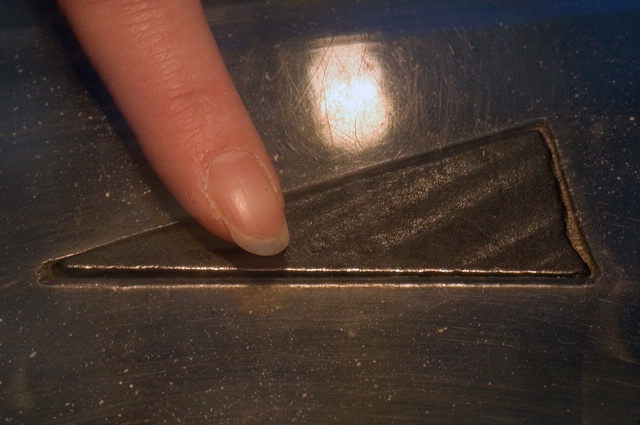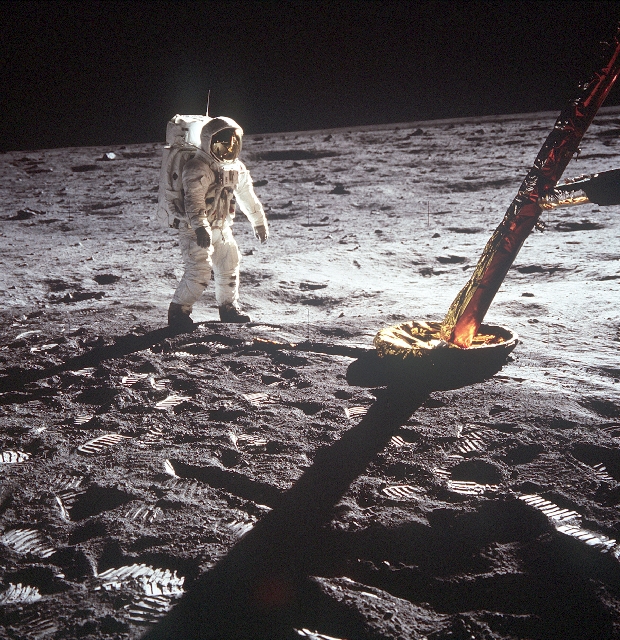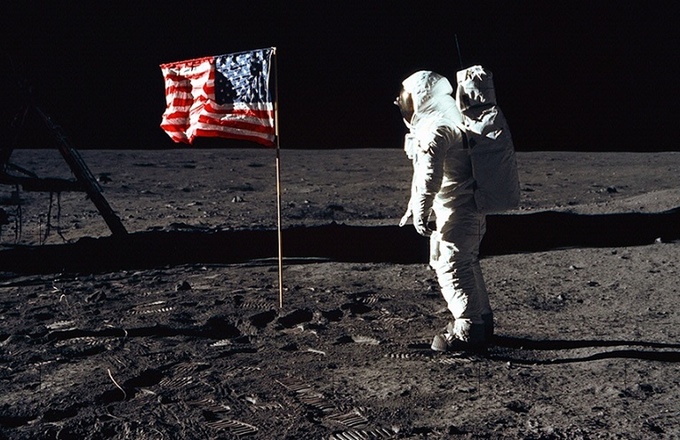Why space travel should still be a national priority
Ken Wang explains how Apollo 11 represents the best of the American spirit and why we need to revive that spirit to tackle to complex issues we face today.
As a volunteer docent at the National Air and Space Museum, I’ve led many visitors to the display where a piece of moon rock was displayed in the rotunda. It’s a tiny, triangular sliver, still incompletely understood, and displayed with a sign, “The study of about 382 kilograms of lunar materials returned on six Apollo missions confirmed the absence of life on the Moon.” A few steps away was the Apollo lunar module that represents one of humanity’s greatest achievements: landing people on another heavenly body.

Visitors can touch a rock from the Moon in the Boeing Milestones of Flight Hall at the National Air and Space Museum in Washington, DC. Four other lunar samples are on display at the Museum. (Photo by Eric Long)
I was a teenage boy in the 1960s and I found the first moon landing enthralling. I remember watching it on our black-and-white television as the world marveled at America’s leadership in space. I also charted the Apollo missions in their entirety and built scale models to commemorate them.
The flight of Apollo 11, a triumph of human endeavor, persistence, and technology, was one of the greatest achievements in history. Back in 1961, Alan Shepard became the first American in space and, only eight years later, two air force pilots and a naval aviator blasted off from Launch Pad 39A at Cape Kennedy, with a rendezvous with history. On July 20, 1969, Neil Armstrong and Buzz Aldrin became the first people to reach the moon when their Apollo 11 lunar lander touched down in the Sea of Tranquility.

Buzz Aldrin walks on the surface of the moon near a leg of the lunar module in this photo snapped by fellow Apollo 11 astronaut Neil Armstrong.(Image: © NASA)
For fans of space exploration, the 50th anniversary of Apollo 11’s mission to the moon is a celebration mingled with melancholy. For all the promised “giant leap for mankind” the mission foretold, the prophesied future of moon bases and journeys to Mars and beyond is still science fiction. Nine Apollo missions were launched moonward, and six of them landed. The cultural memories of those missions remain as bright as a new penny – and the aging astronauts who flew the Apollo space modules retain a status that goes beyond iconic. The last of six moon landings was in 1972. Since then, no one has left low Earth orbit.
The Apollo program taught us that our nation can conquer even the most enormous technological problems if we are willing to devote sufficient energy and resources to solving them.

Astronaut Buzz Aldrin poses for a photograph beside the deployed United States flag during an Apollo 11 Extravehicular Activity (EVA) on the lunar surface. Astronaut Neil Armstrong, commander, took this picture with a 70mm Hasselblad lunar surface camera.
We now face many such challenges, from climate change to energy independence, which we need to tackle, even as we long for a return to the moon and to go on to Mars. Space exploration promises to propel science forward in myriad ways.

National Air and Space Museum director Gen. JR “Jack” Dailey, Mission Control creator and former Johnson Space Center director Dr. Christopher Kraft, Apollo 11 crew members Dr. Buzz Aldrin, Neil Armstrong and Maj. Gen. Michael Collins, Sen. John Glenn and Smithsonian Institution Secretary Dr. G. Wayne Clough in front of the Lunar Module at the National Air and Space Museum on July 19, 2009. (Photo by Mark Avino)
This 50th anniversary of Apollo 11 is a time to think about embarking on another human space adventure, one that might make the ultimate statement about our nature. We can choose to do something that is just barely possible, a unique endeavor in a class by itself.
President Donald Trump directed NASA to go back to the moon with Space Policy Directive 1. The announcement no doubt delighted people who want to see us go back to the moon and establish an ongoing presence there. One of the strongest arguments in support of a “moon first” approach is that the moon can serve as a testbed for technologies that will help support human life on Mars.
Vice President Mike Pence further articulated the need for NASA to make an urgent effort to return to the moon. Pence called for changes in the agency’s approach, reflecting frustration within the administration at repeated delays in the development of NASA’s giant rocket, the Space Launch System, and Orion, a capsule for taking astronauts to the moon. But an accelerated pace has not been evident in the administration’s NASA budget requests to Congress, raising many questions about how it will be possible for the agency to accomplish this ambitious goal.
Over the years, critics have lambasted NASA for losing the boldness that defined it during its early days, dampened by a pair of space shuttle disasters that killed 14 astronauts. Actually, 50 years ago, NASA sent men to the moon, 400,000 kilometers away. Today, our astronauts go to the International Space Station, 400 kilometers away, by hitchhiking on Russian rockets at a cost of more than $80 million a seat. This is because NASA hasn’t had the ability to fly humans to space since the nation’s shuttle fleet was retired in 2011.
China, meanwhile, has emerged as a rival in space. Earlier this year, it became the first nation to land a spacecraft on the far side of the moon. It plans to send another uncrewed mission to the moon later this year. In the process, China has revealed its ambition to seize the lunar strategic high ground and become the world’s preeminent space-faring nation. The plans underscore China’s ambitions in space at a time when the United States is curtailing NASA’s budget and increasingly handing over the business of space exploration to commercial adventurers.
Today, Israel, India, Japan, and China have lunar exploration projects in development. The United States’ own plan is perhaps the most ambitious – to return Americans to the moon by 2024 and eventually use it as a staging point for human flight to Mars and beyond. NASA needs to set firm goals and stick with them to reduce the risk of cost overruns, to enable commercial and international partnerships, and ultimately to maintain its leadership role in space exploration.

Future astronauts enjoy Space Day 2013 at the Smithsonian’s National Air and Space Museum. (NASM photo)
As we celebrate the 50th anniversary of that event, I note that probably more than half the people in the world today were not alive to witness the moon landings. They are the youngest and most vibrant members of our society, and from my experience leading tours at the Air and Space Museum, they seem very interested in space travel. Perhaps, the next generation will revive the spirit of the Apollo missions and take us back to the moon…and beyond.

Kent Wang has been a volunteer docent at the Air and Space Museum since 1997.
Posted: 17 July 2019
-
Categories:
Air and Space Museum , Science and Nature , Volunteer Voices







